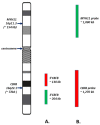CBFB Break-Apart FISH Testing: An Analysis of 1629 AML Cases with a Focus on Atypical Findings and Their Implications in Clinical Diagnosis and Management
- PMID: 34771519
- PMCID: PMC8582369
- DOI: 10.3390/cancers13215354
CBFB Break-Apart FISH Testing: An Analysis of 1629 AML Cases with a Focus on Atypical Findings and Their Implications in Clinical Diagnosis and Management
Abstract
Fluorescence in situ hybridization (FISH) is a confirmatory test to establish a diagnosis of inv(16)/t(16;16) AML. However, incidental findings and their clinical diagnostic implication have not been systemically studied. We studied 1629 CBFB FISH cases performed in our institution, 262 (16.1%), 1234 (75.7%), and 133 (8.2%) were reported as positive, normal, and abnormal, respectively. The last included CBFB copy number changes (n = 120) and atypical findings such as 3'CBFB deletion (n = 11), 5'CBFB deletion (n = 1), and 5'CBFB gain (n = 1). Correlating with CBFB-MYH11 RT-PCR results, totally 271 CBFB rearrangement cases were identified, including five with discrepancies between FISH and RT-PCR due to new partner genes (n = 3), insertion (n = 1), or rare CBFB-MYH11 variant (n = 1) and eight with 3'CBFB deletion. All cases with atypical findings and/or discrepancies presented clinical diagnostic challenges. Correlating FISH signal patterns and karyotypes, additional chromosome 16 aberrations (AC16As) show impacts on the re-definition of a complex karyotype and prognostic prediction. The CBFB rearrangement but not all AC16As will be detected by NGS-based methods. Therefore, FISH testing is currently still needed to provide a quick and straightforward confirmatory inv(16)/t(16;16) AML diagnosis and additional information related to clinical management.
Keywords: CBFB rearrangement; CBFB-MYH11; FISH; RT-PCR; additional chromosome16 aberrations (AC16As); atypical findings; next-generation sequencing (NGS).
Conflict of interest statement
The authors declare no conflict of interest.
Figures





References
-
- Arber D.A., Brunning R.D., Le Beau M.M., Falini B.J.W.V. Acute myeloid leukemia with recurrent genetic abnormalities. In: Swerdlow S.H., Campo E., Harris N.L., Jaffe E.S., Pileri S.A., Stein H., Thiele J., Arber D.A., Hasserjian R.P., Le Beau M.M., et al., editors. WHO Classification of Tumors of Hematopoietic and Lymphoid Tissues. 4th ed. International Agency for Research on Cancer; Lyon, France: 2016. pp. 130–149.
-
- Grimwade D., Walker H., Oliver F., Wheatley K., Harrison C., Harrison G., Rees J., Hann I., Stevens R., Burnett A., et al. The importance of diagnostic cytogenetics on outcome in AML: Analysis of 1612 patients entered into the MRC AML 10 trial. The Medical Research Council Adult and Children’s Leukaemia Working Parties. Blood. 1998;92:2322–2333. doi: 10.1182/blood.V92.7.2322. - DOI - PubMed
-
- Grimwade D., Hills R.K., Moorman A.V., Walker H., Chatters S., Goldstone A.H., Wheatley K., Harrison C.J., Burnett A.K. Refinement of cytogenetic classification in acute myeloid leukemia: Determination of prognostic significance of rare recurring chromosomal abnormalities among 5876 younger adult patients treated in the United Kingdom Medical Research Council trials. Blood. 2010;116:354–365. doi: 10.1182/blood-2009-11-254441. - DOI - PubMed
-
- Hernández J.M., González M.B., Granada I., Gutiérrez N., Chillón C., Ramos F., Ribera J.M., González M., Feliu E., San Miguel J. Detection of inv(16) and t(16;16) by fluorescence in situ hybridization in acute myeloid leukemia M4Eo. Haematologica. 2000;85:481–485. - PubMed
LinkOut - more resources
Full Text Sources

